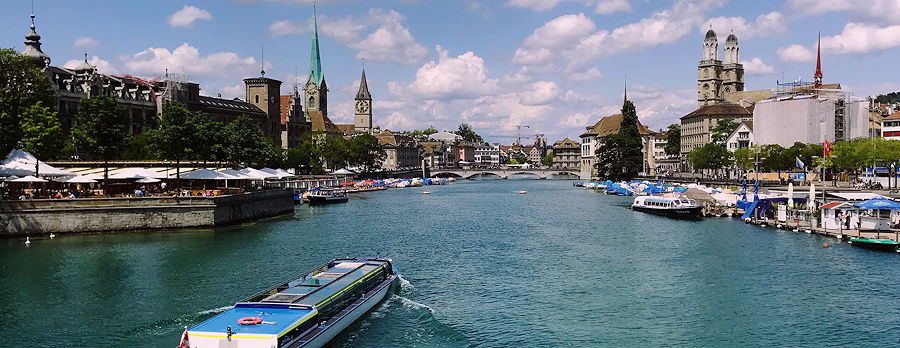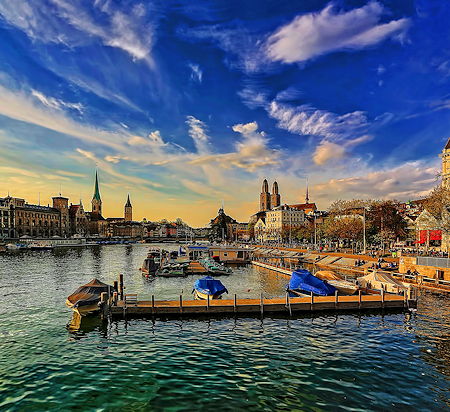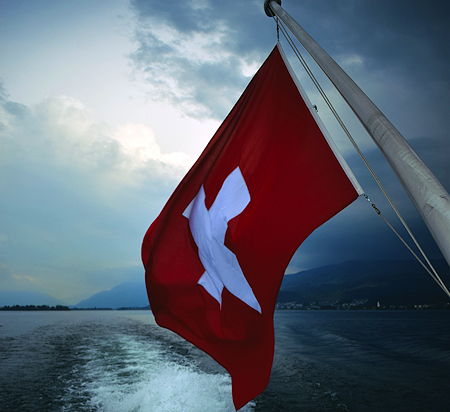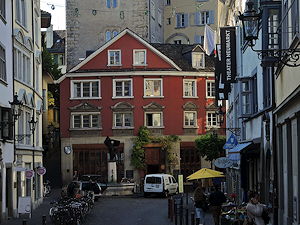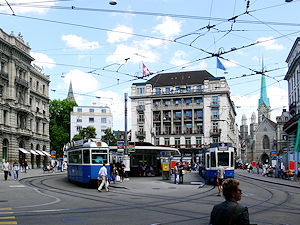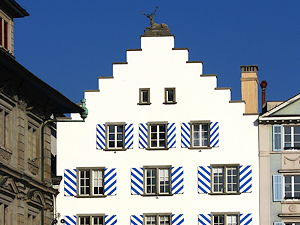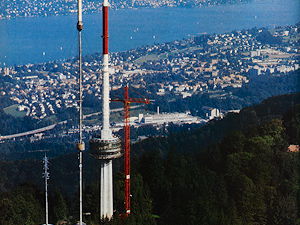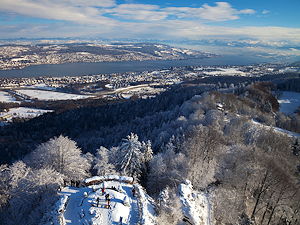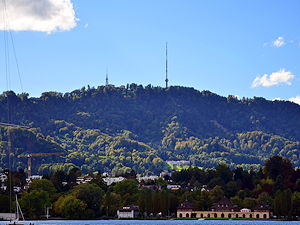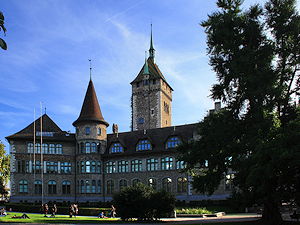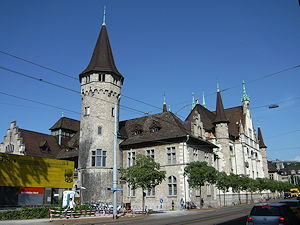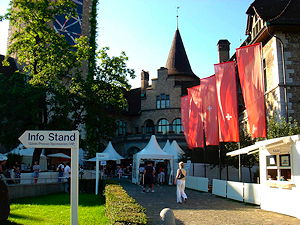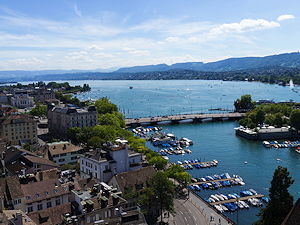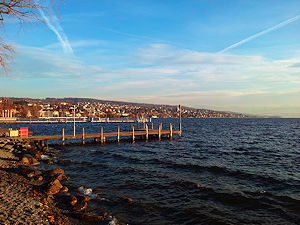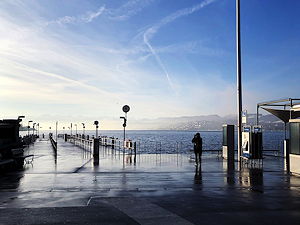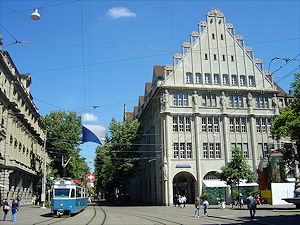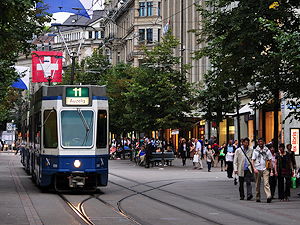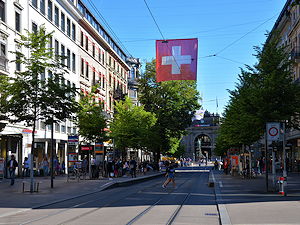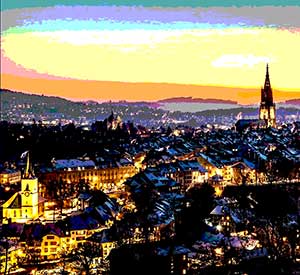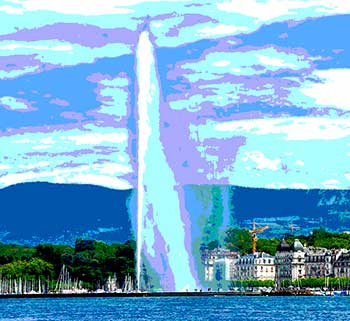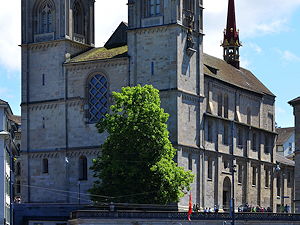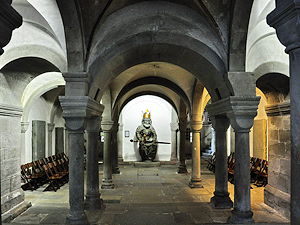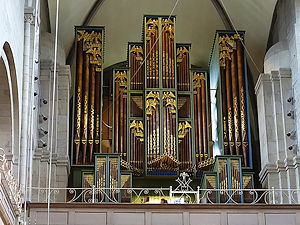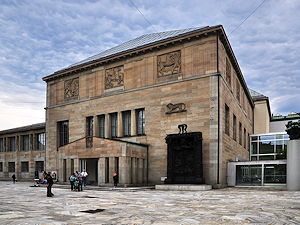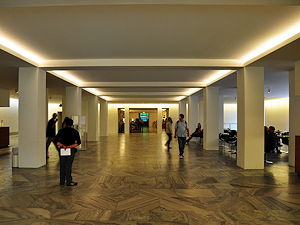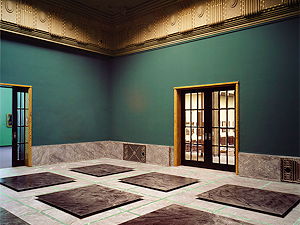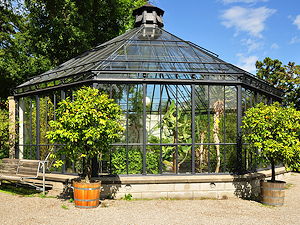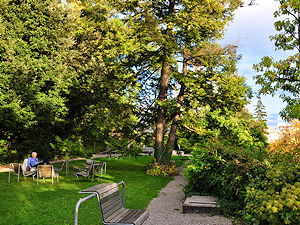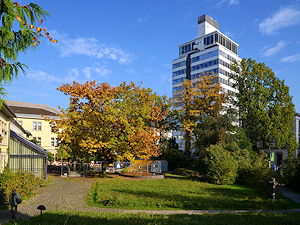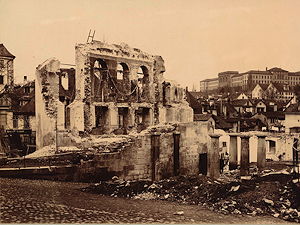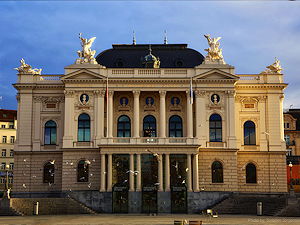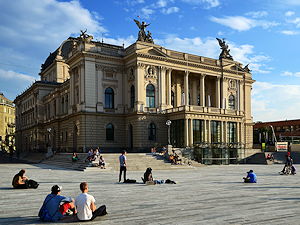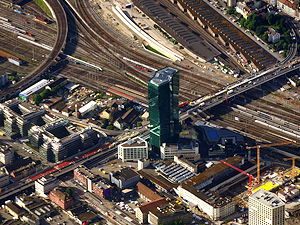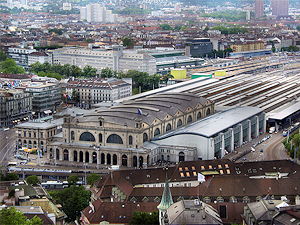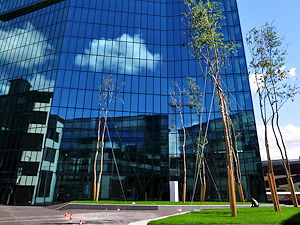Things to do in Zurich, Switzerland
Zurich, Switzerland's largest city, is a global centre of finance and also one of Europe's best nightlife destinations.
Known as the gateway into the Alps, and set along the intersection between the turquoise Lake Zurich and the Limmat River, Zurich is undeniably beautiful.
Culture abounds in its streets with ancient and medieval architecture, regular events and festivals, the impressive Zurich Opera House, and more than 50 museums. Zurich's Old Town is a walk through history itself, while its popular shopping streets and its Zurich West neighborhood bring a dose of hip modernity into the picture.
The crowd is a mix of young students, sharp business professionals, and wide-eyed tourists. Even with this diverse ensemble, the city is always impeccable, and you will not find any trace of trash in the streets. Trains, planes, and trams arrive on the dot, as if tuned to the precise beat of a Swiss watch.
You can also get away from modern life, by climbing the Uetliberg Mountain (offering panoramic views over Zurich and its surrounding mountains) or by visiting the Botanic Gardens. An alternative close to the city centre is the Lake Zurich Promenade.
Found to the north of the country, and with around 400,000 residents and great rail and travel links, Zurich is regularly ranked in surveys of the world's most inhabitable cities.
In short, Zurich seems to have it all: mountains, rivers, lakes, restaurants, culture, museums, shopping, and the largest density of nightclubs in the country. Here are the top 10 things to do in this breathtaking city.
1. The Old Town
Zurich's medieval Old Town (or Altstadt in German) is its most important and eclectic neighbourhood.
The Old Town is a popular spot for tourists and locals alike, as it is a historical, cultural, and nightlife center.
Cobblestone streets wind down narrow alleys and surround beautiful houses; scores of often ugly statues provide interest on every street; and the area is framed by the relaxing waters of the Limmat river.
Walking around the neighborhood is a treat in itself, as every single corner seems to have been charmed with a peculiar grace. A number of restaurants and cafes have popped up along its streets, catering to those enjoying a long stroll through the Altstadt.
The neighborhood houses some of the city's most important religious buildings, such as the Minster of Our Lady Church. It also houses important historical and cultural landmarks, like the Lindenhof and the Swiss National Museum.
The Lindenhof is a Roman castle, which delights visitors with its majestic beauty. So as so perfectly contrast its medieval architecture, the Old Town has seen a surge of bars and nightclubs that have turned it into a nightlife hub.
where? The Old Town can be accessed through various tram stations, of which the Bahnhofstrasse and Rennweg stations are perhaps the most convenient. If on bus, take route N1, N6, or N13 and exit at the Bahnhofstrasse station. MAP
when? You can head to the Old Town whenever you desire. However, keep in mind that Sundays in Switzerland are a day of rest, and you will not find many shops or restaurants open. If heading to a specific museum, landmark, or bar, make sure to look up its hours of operation.
£$€¥ Walking through the neighborhood presents no charges, except those accrued through purchases, and/or fees at museums.
2. Üetliberg Mountain
Breathtaking views, tranquil trails, and scenic paths make Uetliberg Mountain one of Zurich's most popular attractions.
At 2,858 feet above sea level, the mountain is the perfect place to catch a panoramic view of Zurich and the surrounding Alps. Though it is outside of the city itself, it is well-worth the effort, as it gives visitors an opportunity to witness postcard-perfect Switzerland.
There are numerous trails and paths that lead up, down, and along the mountain. Visitors can hike, walk, and bike through them at their own discretion and pace. Because the paths are marked and they do not present an extreme challenge, they are suitable for all ages and levels.
On weekends, the mountain receives numerous families, tour groups, and individuals who seek to escape into nature while maintaining the modern commodities offered at the top: restaurants, clean bathroom facilities, and even a hotel.
where? To get to Uetliberg Mountain, you can take a train from the Hauptbahnhof station in Zurich. The train takes about half an hour and leaves you at the foot of the mountain. Train tickets cost around CHF18 for adults, and CHF9 for kids roundtrip (half-fare cards accepted). Holders of the ZurichCARD do not need to purchase tickets. MAP
when? The paths up the mountain never close, so you are free to visit whenever you like. However, it is important to take train times into consideration, as they do not operate uninterrupted. It is also advisable to not hike at night: while crime is practically unheard of, it is better to be cautious.
£$€¥ There is no charge to go up the mountain. However, visitors who wish to see the 360° view from the top of the observation deck will have to pay CHF3. Prices at the bars and restaurants tend to be expensive.
3. Swiss National Museum
Situated on a castle, the Swiss National Museum offers a thorough journey into the nation's history.
People say that visiting the museum (also known as the Landesmuseum) is worth it even if just to see its impressive architecture. The collection that it houses, however, is just as worthy of admiration. Starting four centuries before Christ, the museum takes visitors through a comprehensive history of Switzerland.
With permanent exhibitions that include information on important events, lifestyle, and national art, it provides an opportunity to understand the country's past and present.
The Museum's 14 collections, which house over 800,000 objects, include Archaeology, Painting & Sculpture, and Textile & Fashion. The most unusual collection is called "Carriages, Sledges & Wagons", and includes an 18th century sledge in the shape of a lady's shoe.
Temporary exhibitions bring fresh perspectives to the museum. Showcasing new artists, and representing modern issues, they are the connection to modern-day Switzerland that makes the museum invaluable. The current exhibition, on display until June 2016, celebrates the 500th anniversary of the birth of naturalist, scholar and Geologist Conrad Gessner.
Because of its size, visitors often spend hours, if not an entire day, browsing through the exhibitions. The museum takes pride in being interactive and innovative, and it is considered one of the finest museums in the nation.
where? The museum is located on Museumstrasse 2, in the Old Town. The Hauptbahnhof and Bahnhofquai stations are the closest to it. Both can be reached through various tram and bus lines. MAP
when? The Swiss National Museum is open Tuesday through Sunday. It opens at 10:00 a.m., and closes at 5:00 p.m. every day except for Thursdays, when it closes at 7:00 p.m. There is no entrance on Mondays.
£$€¥ People 17 and older pay CHF10 to enter the museum. Anyone 16 or younger, as well as holders of the ZurichCARD can enter free of charge.
4. Lake Zurich Promenade
Beautiful lakefront views and an extensive network of promenades and gardens make Lake Promenade the perfect plan for a sunny day.
Lake Zurich is undeniably picturesque. Its waterfront is decorated by colorful houses packed tightly together. Shops and restaurants line up along it, offering everything under the sun. Add to this parks, gardens, and promenades, and it is not difficult to see why this is often ranked as the #1 thing to do in Zurich.
The promenade is always busy, but on sunny days, you will see half of the city head down to the water. Families pack picnics, foodies sit at the outdoor terrace of cafes, and tourists walk up and down, capturing as much as they can. Boat tours float along the lake, offering a unique and interesting perspective of the city.
Because of the myriad of choices it offers, it is a wonderful opportunity to take a break from hectic sightseeing, and simply enjoy the city.
where? The Lake Promenade expands over a large area of Zurich, but it is most easily accessed through the Bhf Wollishofen station. Several tram lines, as well as bus routes 161, 165, and N15 connect to it. MAP
when? As it is an open-air area, the promenade is always open to the public. While it is always lovely, sunny days during spring and summer are the best times to enjoy the area.
£$€¥ Strolling around the lakefront is absolutely free of charge. However, the boat tours are highly recommendable and cost around $9 for adults. Visitors might also want to spend money on restaurants, cafes, and shops.
5. Bahnhofstrasse
One of the world's most famous shopping strips, this is the place to find world-class brands and high-end dining.
Anyone looking to buy Gucci and Chanel, as well as top Swiss brands, will find everything they need on this street. Distinctive for being an attractive station street (bahnhofstrasse), it is one of the most frequented places in Zurich.
Those who do not wish to buy brand names can still enjoy walking about, and window shopping. A number of top restaurants can be found here, so it is a wonderful place to stop for a rest and enjoy the best the city has to offer.
Strolling around the Bahnhofstrasse is a great way to people-watch and see locals in their daily lives.
where? The Bahnhofstrasse spans between the Old Town and Lake Zurich. There are several stations that will take you into the area, including the Bahnhofstrasse, Rennweg, and Hauptbahnhof stations. MAP
when? This area is always open, and good for all types of weather. Store hours vary, so if you're interested in particular places, make sure you check out their hours online.
£$€¥ Money spent depends entirely on the person. An avid shopper can spend hundreds, even thousands of dollars, but this is not the case for everyone. Expenses vary on products bought and money spent in restaurants, cafes, and bars.
People also like
6. Grossmunster
This Romanesque Protestant church was built during the 12th century, and is now one of the most iconic landmarks in the city.
Ask any local about the Grossmunster and they'll tell you that it is one of the prides of the city. Its twin towers topped by identical cylinders preside over the city and reflect beautifully on the river. Unique stain-glass windows filter the sunlight that decorates its interior with a kaleidoscopic effect and permeates the church with a sense of tranquility.
The Grossmunster is also connected to important historical figures. Local legend claims that the site of the church are the graves of Felix and Regula, the patron saints of the city. After learning this -the story goes- Charlemagne himself commissioned its building.
It is also from here that the father of the Swiss Reformation, Heinrich Zwingli, conducted much of his business and changed the religious and political landscape of the country. Without a doubt, this is one of Switzerland's most recognized churches.
where? The Grossmunster is located in the conveniently named Grossmünsterplatz in Old Town. The best way to reach it is by foot, as walking about the historical part of the city is truly a treat. MAP
when? The church is open every single day of the year. From March to October its hours are 10:00 a.m. to 6:00 p.m. Monday to Saturday, and after service on Sundays. From November to February it is open from 10:00 a.m. to 5:00 p.m. Monday to Saturday, and Sundays after service.
£$€¥ Entering this place of worship is, of course, free of charge. However, if you're a history lover who wants to take a self-guided tour, you can purchase it for $2. If you want to go up to the top of the towers and get an incredible view of Zurich, entrance is $4.
7. Kunsthaus
With works ranging from the Middle Ages to Modernity, the Kunsthaus is home to a truly impressive art collection.
Built in 1910, this art museum is regarded as one of the most important in the entire country (ranking just behind Bern's Kunstmuseum).
Its collection boasts many great works of art, but is most famous for its impressionist and modern art section, which includes pieces by masters like Van Gogh (his Thatched Roofs by Auvers is the highlight), Picasso (including his Guitar on a Table), Cezanne (with one of his Mont Saint-Victoire works on display), Monet (ten of his works are on display including two of his water lily paintings), and Matisse (including his 1907 work Margot).
The Kunsthaus has also established a reputation for its emphasis on Swiss artists, such as Jonathan Heinrich Fussli and Alberto Giacometti.
The Kunsthaus is constantly expanding to fit additions to its permanent exhibits. Its temporary exhibits draw large numbers of people and are renowned for their excellent collections and thoughtful curatorial work.
2019's temporary exhibitions include Matisse: Metamorphoses (August to December), Picasso - Gorky - Warhol (September 2019 to January 2020), Wilhelm Leibl: The art of seeing (until 19.01.2020) and The New Photography (until 09.02.2020)
Art and history lovers visiting Zurich cannot miss it.
where? The museum is located on Heimpl. 1. It is serviced by trams and buses that pass through the Kunsthaus stop. The stop is located right outside of the museum so it is very convenient. MAP
when? The Kunsthaus has a peculiar schedule. It is open Tuesday, and Friday through Sunday, from 10:00 a.m. to 6:00 p.m., and Wednesday and Thursday from 10:00 a.m. to 8:00 p.m. It remains closed on Mondays.
£$€¥ Admission to the permanent collection is usually CHF16 per adult (CHF11 for children) and includes an audio guide. Those who wish to only see the temporary exhibition can pay CHF23 for admission. However, the best value is the combined ticket, which includes both the permanent collection and the temporary exhibition for CHF26 (children: CHF19). Students and holders of the ZurichCARD enjoy discounts, and youth under 16 years of age can enter free of charge. On Wednesdays the museum offers free admission for the general public.
8. The Old Botanical Garden
Often confused with the Botanical Garden of the University of Zurich, the Old Botanical Garden was the first of its kind in the city.
Founded in 1837, the Old Botanical Garden is still one of the most pleasant places in Zurich. Its central location makes it accessible for both locals and visitors who wish to step into an enchanting green space.
The garden is dotted with various beautiful and interesting species, and also counts with different spaces that add to its charm. The octagonal glass pavilion creates a dialogue between the inside and the outside, the arboretum is a perfect place to relax, and the medieval herb garden provides some insight into medicine in the middle ages.
The palm house is the space that gets the most attention, since it often hosts concerts, art exhibits, and plays. There are also several sculptures that play with and decorate the landscape.
What makes the Old Botanical Garden one of the best things to do in Zurich is its buzz and the range of activities that one can enjoy here.
where? The Old Botanical Garden is conveniently located in the city centre at Pelikanstrasse 40. It is accessible from tram lines 2 and 9 at the Sihlstrasse stop. MAP
when? For the pleasure of the public the garden is open daily throughout the year. From April to September the hours of operation are 7:00 a.m. to 7:00 p.m.; from October to March it is open from 7:00 a.m. to 6:00 p.m. Any time of day is a good time to visit the garden, though there will be less people during the early morning.
£$€¥ Like all great gardens, the Old Botanical Garden is completely free of charge and open to the entire public. However, some of the events held at the garden may charge a price.
9. Zurich Opera House
With prestigious companies performing some of the world's greatest ballets and operas, the Zurich Opera House is the perfect place to spend a cultural evening.
As one of the Zurich's most important cultural centres, the Opera House holds a special place in the hearts of locals. After all, it is here where they enjoyed special plays as children, where they saw Romeo and Juliet for the first time, and where they can go to listen to incredible renditions of Wagner's symphonies.
Sitting more than a thousand people, this is one of the world's great opera houses (alongside the Opera Houses of Sydney and Vienna), and its repertoire of ballets, operas, and concerts definitely reflects this status.
This opera house was built in 1891 over the old one that burnt down in a tragic fire. The building itself is a work of art, and even those who are not particularly interested in operas and ballets enjoy seeing the inside of this architectural gem.
where? The Zurich Opera House is located on the river bank at Falkenstrasse 1 in Sechselaeuten Platz. Numerous bus and tram lines service it at the Opernhaus stop. MAP
when? The best time to visit the opera house is, of course, in the evening during a show. At this time you will see a line of elegantly dressed people claiming their tickets. There is no set hour of closing for the opera, as it depends on the evening's repertoire. However, if you'd like to go in just to see the building, do it during the daytime when there are no shows playing.
£$€¥ Ticket prices vary depending on the show, date, times, and seats. Prices range from $30 to $400, but are usually at least $100 for adults. There is a 5% discount offered to holders of the ZurichCARD. If you wish to see the building but not a show, you can enter for free.
10. Zurich West
Once an industrial district full of factories and warehouses, Zurich West is quickly becoming the city's hippest neighborhood.
Twenty years ago no tourist would have had a reason to step foot in Zurich West. After all, there was nothing charming about abandoned warehouses and old ship-building factories. Today, however, the neighborhood is drawing attention from all corners of the world, as it experiences an interesting artistic revival.
Empty warehouses have been turned into museums, boutique shops, and underground theaters, and some of the concrete blocks have been replaced by trendy and sophisticated designs that cater to a younger crowd.
Zurich West is now a mecca of art and design, boasting city gardens, second-hand stores, and street art. It is also known for its amazing culinary scene, with concept restaurants that are imagining new ways to mix it up.
Like any self-respecting hipster haven, the neighborhood has the best nightlife in the city.
where? Zurich West is District 5. As an relatively big neighborhood, there are several places to start exploring. Take trams 4, 13, or 17 to Escher Wyss Platz or tram 4 to Technopark to begin at a centralized location. MAP
when? The neighborhood is great at any time of day. Mornings and afternoons can be spent visiting local markets, shopping at thrift stores, and walking through galleries. Nights are perfect for enjoying the culinary scene and nightlife.
£$€¥ Spend as little or as much as your heart desires. Some of the best neighborhood experiences like hunting for the best mural are completely free of charge. Shops, bars, and restaurants are usually reasonably priced, though they are becoming more expensive as the district becomes more popular.
